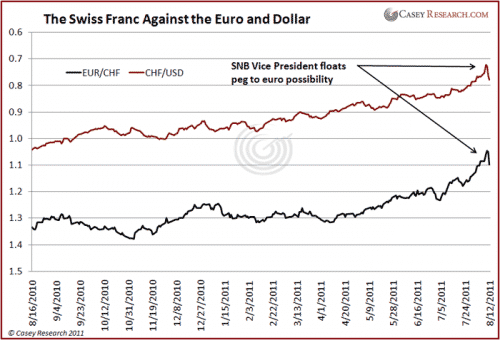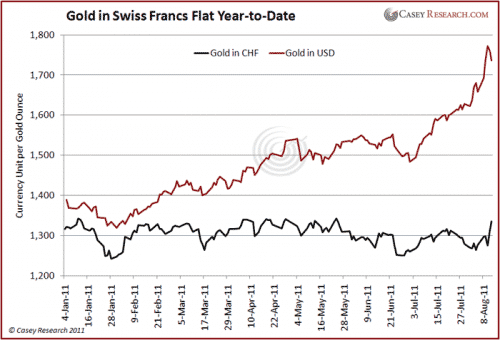Pegs, Pomp, and Direct Democracy
By Kevin Brekke
In characteristic form, the currency traders and those who trade in what is dubbed "financial news" woke up last week and discovered, à la Rip Van Winkle, that the Swiss franc was a haven currency charging higher. Never you mind that it has been on a steady carabiner-and-rope-assisted climb for well over a year. The experts missed all the action and profit of the ascent until the flag was nearly planted at the summit – a sure sign of an interim top.
The strength of the Swiss franc (CHF) was prominent among the headlines dominating last week’s news cycle as it hit mid-week, intraday, all-time highs against the dollar (0.707) and euro (1.008). Over the past 52 trading weeks the franc is up roughly 18% versus the euro and a tourism-threatening 25% against the USD. Here’s a chart of the move:
(Click on image to enlarge)
The "horns down and snorting" posture of the franc has had the Swiss National Bank (SNB) on the defensive for several weeks (actually for over a year, as I explain below). On August 3, the SNB intervened and added bank liquidity, deployed forex swaps transactions, and narrowed its target band for the three-month Libor to 0.00-0.25% from 0.00-0.75% – signaling, in effect, that rates will be taken to zero if necessary.
The intent, of course, was to halt the rise of the franc. But like all currency interventions, the outcome was not as planned. The efforts of the SNB are seen in the chart as a brief plateau in the franc’s movement against the euro before resuming its north-by-northeast chart heading – and then the big fall. From a trader’s perspective, that was a "pause that refreshes."
Let’s get frank about the franc
On Thursday, after the rusty old tools of central bank interventions past had failed to do the trick, the SNB came out with a new tactic that was, well, preposterous pageantry. SNB Vice President Thomas Jordan suggested that a "temporary link with Europe’s common currency" might be allowed under the bank’s mandate so long as it did not compromise Switzerland’s monetary independence.
Whether or not the statement was a calculated attempt at talking the currency down or not, it was certainly creative… and it worked. So much so that it rocked the market on its heels. The franc went into freefall and had its biggest one-day decline against the euro, down 5%.
But aside from successfully reversing the franc’s rise, the whole idea is a non-starter. The notion that a fiercely independent country that is running both current account and budget surpluses would align its economic policy with an external central bank that is proving itself daily to be incompetent at managing a union of fiscal misfits hardly seems practical. And it may not be legal.
The mandate of the SNB is written into the Swiss Constitution. Article 99 of the Federal Constitution requires the SNB to ensure three primary objectives: price stability, inflation forecasts, and interest rates. The wording of the SNB’s monetary policy strategy is broad and general, and the legality of any move to peg the franc to another currency is fuzzy.
However, the mood of Swiss voters is far from fuzzy.
Mood swing
The relationship between the SNB and those who daily use its currency has been rocky. As background to the "peg the franc to the PIIGS" story, consider two courses of action undertaken by the SNB.
In 2000, the SNB embarked on a program of gold sales that would reduce the country’s holdings by 50% over a then yet-to-be-determined timeline. The decision was approved via national referendum the previous year. Until the late 1990s, the SNB was legally required to maintain 40% gold backing for the Swiss franc note, thus restricting gold sales. A 1996 report from the Swiss finance ministry suggested the gold cover should be reduced from 40% to 25%. The bank’s chairman described the 40% backing as "a relic of the past."
At the outset the program seemed like a prudent step. Gold was selling for under US$300/oz, and all was quiet in the Western economies. And Gordon Brown, then the UK’s chancellor of the exchequer, in 1999 had sold half of his country’s gold.
The gold sales dragged on for years, and concluded in 2008 with the final sale of 137 tonnes. By this time the world had changed for the worse, and was in the throes of the worst financial crisis in history. Jump to 2011, and the price of gold is several multiples of the average price the SNB received for its gold. The mood of the natives was changing.
Then, in July 2011, it was revealed that the SNB had suffered an accumulated loss of US$36 billion in the 18 months through June due to intervention in the currency markets to stem the rise of the franc – a gambit the above chart exposes as an utter failure – a loss that equaled 7.5% of GDP.
The popular mood has turned sour.
Direct from ballot to constitution
No surprise then that there is a movement afoot in Switzerland to force changes in the current currency regime, including the rebirth of a circulating coin with gold content:
The Swiss Parliament is expected later this year to discuss the creation of a gold franc – a parallel currency to the official Swiss franc, with the fringe initiative likely triggering a broader debate about the role of the precious metal in the Alpine nation.
The initiative is part of "Healthy Currency," a campaign sponsored by politicians from the right-wing Swiss People’s Party (SVP) – the country’s biggest – that is seeking to capitalize on popular fears about global financial turmoil and inflation to reverse the government’s current policy on gold.
"I can imagine that this will spark some sort of debate about gold and there may be some pressure to accept the parallel currency," said Dr. Gebhard Kirchgässner, an economics professor at St. Gallen University. "But it won’t have any real effect on the economy. It seems incredible to imagine that there are people out there willing to buy millions of these things."
The man behind the gold concept, Thomas Jacob, begs to differ:
"I want Swiss people to have the freedom to choose a completely different currency," he said. "Today’s monetary system is all backed by debt – all backed by nothing – and I want people to realize this."
The new gold franc would sport a gold content of 0.1 grams. Jacob’s model would allow the private minting of gold coins; wants to limit the autonomy of the Swiss National Bank; and wants Switzerland to withdraw its membership in the IMF.
The SVP plans to start collecting signatures for a ballot initiative in mid August, according to Jacob. The party is also demanding that the central bank be prohibited from any further gold sales and to repatriate Swiss gold reserves held abroad. A stipulation that the proportion of gold not fall below 20% of its total assets is also part of the initiative. Also from the MarketWatch article:
Jacob, who claims to have no affiliation with the SVP other than the currency initiative, admits that the success of his gold franc campaign is linked to the amount of publicity the Healthy Currency initiative manages to muster at the end of the summer. "It would definitely put the parallel currency on the agenda," he said.
And it will be no easy feat. The passage of the legislation will require an amendment to the Swiss constitution and the country is not particularly well known for a reckless pace of change. If rejected, a popular vote – where ordinary Swiss people have their say – is planned, probably in mid 2012, according to Jacob.
If approved, licensed financial institutions can then issue the coins, using their official logo on one side with the other, an easily recognizable Swiss gold franc emblem, Jacob said. The initiative foresees strict regulation by the government to ensure gold content and authenticity.
Note the negative mainstream party-line rhetoric of the article and derisive slant on gold. All bias aside, if this initiative is successful it would surely cause the franc to rise in a sustainable way. The flood of money into the country seeking refuge in a currency newly alloyed with gold would be impossible to stem by the SNB or any other central bank.
Goodbye peg.
What next for the franc?
The franc is way overbought at this point, and has simply moved too far too fast for too long. However, the franc has moved in concert with gold for all of 2011, acting as a magnet for capital fleeing the debt-distressed currencies of the West. This is evident when you look at a chart of gold in Swiss francs versus gold in U.S. dollars.
(Click on image to enlarge)
For 2011 through Friday, August 12, gold is up 1.5% in francs while concurrently rocketing 25+% in dollars. The nearly matching percentage move against the dollar has kept the gold price flat in francs.
For now, the SNB has bought itself some time by triggering a sharp sell-off in the currency with Thursday’s peg-and-pomp side show. But then, all central banks use deception – it’s one of the first things pulled out of the trusty toolbox.
What next? If we look for examples of policy responses by other countries, the SNB may go the capital control route, as is being done by Latin American countries to deal with massive inflows of hot money. But there, too, the success of these interventions has been dubious.
Whatever course the Swiss choose, it will likely yield only temporary relief. The global flow of money seeking safe harbor in an increasingly unstable world cannot be stopped. For the individual investor, attempting to chase the latest and greatest currencies is a recipe for financial disaster. Moving into hard assets like gold (and silver) is the only answer.
[The beginning of the end of the fiat money experiment has begun. Being prepared for the death of paper money is the only way to ensure financial survival beyond the trailing edge of the crisis that is now upon us. To that end, the next Casey Research Summit, titled When Money Dies, will take place October 1-3 in Phoenix, AZ. Learn more about it and sign up soon – it’s filling up fast.]


Comments are closed.